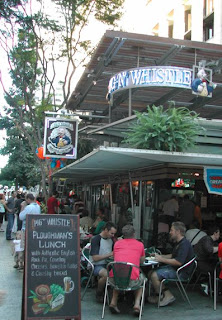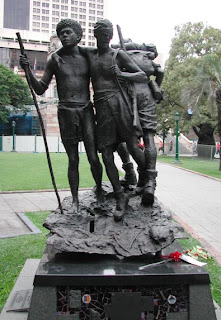 In the yard of the Cathedral of St Stephen is a sculpture honoring the Right Reverend James O'Quinn who was first Catholic Bishop of Brisbane. The Cathedral History outlines how the first St Stephen’s church became a cathedral when James Quinn was appointed first bishop of the diocese in 1859. He arrived in Brisbane on Friday night 10th May 1861 and, the following Sunday in St Stephen’s, took possession of the diocese. Two and a half years later, on the feast of Stephen in 1863, he laid the foundation stone of a bigger cathedral.
In the yard of the Cathedral of St Stephen is a sculpture honoring the Right Reverend James O'Quinn who was first Catholic Bishop of Brisbane. The Cathedral History outlines how the first St Stephen’s church became a cathedral when James Quinn was appointed first bishop of the diocese in 1859. He arrived in Brisbane on Friday night 10th May 1861 and, the following Sunday in St Stephen’s, took possession of the diocese. Two and a half years later, on the feast of Stephen in 1863, he laid the foundation stone of a bigger cathedral.
 Bishop Quinn was born on the 17th March 1819 at Rathbane, County Kildare, Ireland. He was consecrated in Dublin on the 29th of June, 1859. In 1860 there were only two priests, two churches, two small schools, and 7,676 Catholics, out of a total population of 28,056. He established a Catholic paper, "The Australian", funded two orphanages and an industrial school, erected the cathedral of St. Stephen, and created and conserved rich educational and other endowments. State aid was finally withdrawn from all denominational schools with the close of the year 1880; but at his death, 18th August, 1881, there were 52 Catholic primary schools in the diocese, attended by 6,510 children.
Bishop Quinn was born on the 17th March 1819 at Rathbane, County Kildare, Ireland. He was consecrated in Dublin on the 29th of June, 1859. In 1860 there were only two priests, two churches, two small schools, and 7,676 Catholics, out of a total population of 28,056. He established a Catholic paper, "The Australian", funded two orphanages and an industrial school, erected the cathedral of St. Stephen, and created and conserved rich educational and other endowments. State aid was finally withdrawn from all denominational schools with the close of the year 1880; but at his death, 18th August, 1881, there were 52 Catholic primary schools in the diocese, attended by 6,510 children.
In researching Bishop Quinn, it is true he achieved a great many things during his time in Brisbane. However, he wasn't without his detractors. His religious zeal, and his founding of the Queensland Immigration Society which brought out ten ships with about 6000 migrants, mainly Irish, didn't endear him to all and sundry. He seemed to court controversy both within and outside the church during his time as Bishop. He is a significant part of Brisbane's early history, and has left a lasting legacy with the establishment of the Cathedral.
Cheers, I Love Brisbane, Wes.
Click Here for the Google Map Reference for this post.






















































